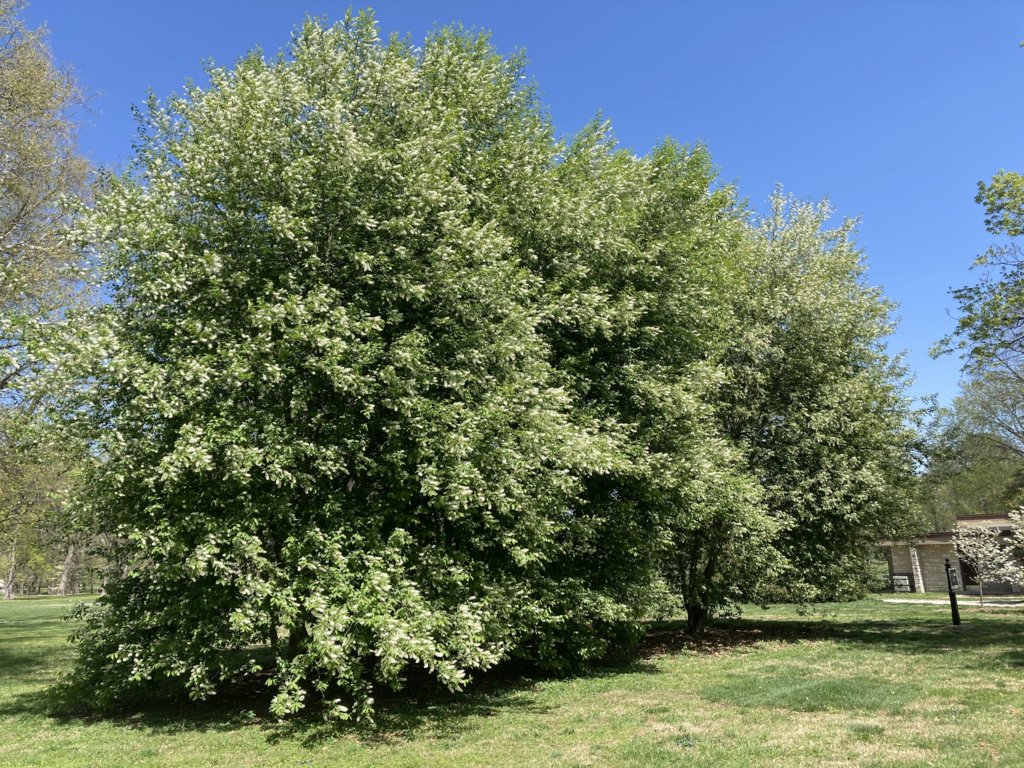By: Mark Halpin, Forestry Manager
Chokecherry, bitter cherry, bitter berry, bird cherry – none of the common names assigned to Prunus virginiana make it sound like something you’d want to eat. Yet it was a prized food source for the indigenous people of North America throughout its native region. It was eaten fresh, in the form of dried cakes or as an ingredient in pemmican, the dried meat dish that was an important part of much Native American cuisine. As with black cherry (Prunus serotina), the inner bark has a long history of use as a medicinal concoction by natives and immigrant settlers alike (a vestige of which survives in the ghastly synthetic “cherry flavor” so common in cough syrups) and was also a common ingredient in “kinnikinnick”, the herbal smoking mixture used by many native tribes. The Navajo used the wood for prayer sticks and flutes and considered the whole plant sacred. Most of us are so used to the tame, sugar-rich taste of cultivated fruit that we can’t appreciate the wild bitterness of chokecherries, but we can all certainly agree on one thing: This plant’s flowers have one of the most luscious, sweet fragrances to ever grace the springtime air. Born in 2-4” clusters that open rather slowly, they often provide multiple weeks of this glorious aroma.
Chokecherry’s growth habit is highly variable, ranging from a scraggly shrub to small tree. In St. Louis, towards the southern edge of its native range, it can reach 30 feet in height and spread, usually as a rounded and dense tree branching low to the ground. It is an adaptable plant, tolerant of full sun and part shade, dry and moist soil, high or low ground, and all-around easy to grow. Expect all of the usual pests of the Rosaceae family (fire blight, leaf spot, powdery mildew, etc.) to be potential problems, but not to the degree they would be for most ornamental cherries. Suckers will likely form and will need to be cut to preserve a tree form, or old wood may be removed periodically to encourage a shrubby habit. ‘Schubert’ and ‘Canada Red’ are popular purple-leaf cultivars that have a more consistent single-stem form. They fit well in more formal gardens, and make rather excellent street trees (this is the only Prunus I would recommend for street tree use unless conditions are exceptional). Early pollinators will be delighted by the presence of chokecherry. And as the season wears on, don’t be freaked out by some insect herbivory on the leaves! Several butterfly and silk moth species’ larvae will feed on its foliage, so other than tent caterpillars or fall webworm, try not to worry too much and leave the critters to their munching.
The best way to experience a chokecherry in bloom is to find a wide, low-branching or thicket-forming specimen and gently work your way into its interior towards the main trunk(s), so you are completely surrounded on all sides by its flowering branches. Once you find a comfortable spot, take a few moments to just simply exist in the presence of one of nature’s finest fragrances. Let yourself swoon a little bit. Smells this deep and layered and wonderful have a way of conjuring up a rich brew of associations and half-recalled pasts, all the fine memories of weather turning warm. Drink deeply. Try not to startle anyone when you emerge from the thicket.
The fruit is loaded with antioxidants. Who knows, maybe it’ll have a second life as the next “superfood”, and we’ll be buying tiny expensive bottles of chokecherry juice in the future.




